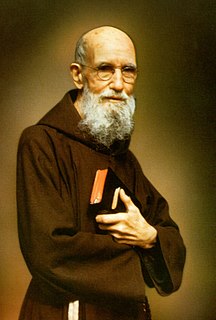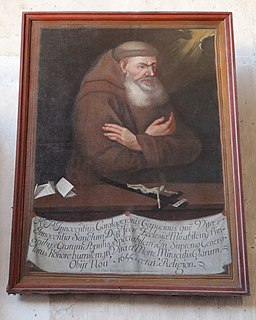
Solanus Casey, born Bernard Francis Casey, was a priest of the Catholic Church in the United States and was a professed member of the Order of Friars Minor Capuchin. He was known during his lifetime as a wonderworker, for his great faith, and for his abilities as a spiritual counselor, but especially for his great attention to the sick, for whom he celebrated special Masses. The friar was much sought-after and came to be revered in Detroit, where he resided. He was also a noted lover of the violin, a trait he shared with his eponym, Saint Francis Solanus.

Leopold Mandić, O.F.M. Cap., , was a Croatian Capuchin friar and Catholic priest, who suffered from disabilities that would plague his speech and stature. He developed tremendous spiritual strength in spite of his disabilities and became extremely popular in his ministry as a confessor, often spending 12–15 hours in the confessional.

Bernardo da Corleone, born Filippo Latini, was a Roman Catholic professed religious from the Order of Friars Minor Capuchin.

Ignazio da Laconi - born Vincenzo Peis - was a Roman Catholic professed religious born in Sardinia, from the Order of Friars Minor Capuchin. His conquering a serious illness prompted him to consecrate his life to God and therefore entered the religious life though not as an ordained priest. Peis was better known in Sardinia for his humble demeanor coupled with his concern for those who were poor. He mingled with all people he met and was generous towards those who were ill. But he became known as a wonder worker and it was claimed that he had performed 121 miracles during his life.

Szymon of Lipnica was a Polish Roman Catholic priest and a professed member from the Order of Friars Minor. He became a sought after and noted preacher and took as his preaching inspiration Saint Bernardine of Siena and also was a strong proponent of popular devotions that he worked to spread.

Ippolito Galantini was an Italian Roman Catholic and the founder of the Congregation of Christian Doctrine. Galantini became a noted educator in Florence and Pope Leo XI - an associate of his - dubbed Galantini as the "Apostle of Florence" due to his activism in educational affairs. He was subject to malicious attacks - even one failed assassination attempt - and was once accused of harboring heretical views though was exonerated from all charges.

Francesco Maria da Camporosso - born Giovanni Croese - was an Italian Roman Catholic professed religious from the Order of Friars Minor Capuchin. Croese became a beggar in Genoa where he sought alms from people and was at first heckled and assaulted before his reputation for personal holiness spread which prompted people to come and see him.

Blessed Leopold of Alpandeire - born Francisco Tomás de San Juan Bautista Márquez y Sánchez - was a Spanish Roman Catholic professed religious of the Order of Friars Minor Capuchin. His life is not distinguished for spectacular works but rather for the humble and simple life in which he led his life as well as for his kindness - in particular towards the most deprived persons. He spent most of his life in Granada where its people still remember and celebrate him as a model example of Christian life and virtue.

Giacomo Gaglione, T.O.S.F. was an Italian member of the Third Order of St. Francis, and a lifelong invalid, who became the founder of the Apostolate of Suffering. On 3 April 2009, he was declared venerable by Pope Benedict XVI and the Congregation for the Causes of Saints has opened his process of beatification.

Blessed Giacinto Bonaventura Longhin - in religious Andrea di Campodarsego - was an Italian Roman Catholic prelate and professed member from the Order of Friars Minor Capuchin who served as the Bishop of Treviso from 1904 until his death. Longhin held various roles of leadership within his order following his ordination such as acting as a teacher in Udine and acting as the Provincial Minister for his order. He became close friends with the Patriarch of Venice Giuseppe Melchiorre Sarto. The latter became Pope Pius X in 1903 who made his old friend Longhin the new head for the vacant Treviso episcopal see.
Giacomo Abbondo was an Italian Roman Catholic priest who hailed from Vercelli. Abbondo served as a pastor and provost in his home town of Tronzano where he administered to the people while proclaiming the message of the Gospel and bringing the sacraments to his parishioners.
Maximiano Valdés Subercaseaux - in religious Francisco - was a Chilean Roman Catholic prelate who was a professed member from the Order of Friars Minor Capuchin and served as the first Bishop of Osorno from 1956 until his death. Valdés discerned his call to the priesthood while with his parents in Europe and was ordained as a priest in Venice after completing his studies in Rome but continued further formation amongst the Franciscans in Europe before making his return to Chile. He was the first Chilean to have become a Capuchin friar. Valdés dedicated his episcopal career to the poor and he often visited the poor regions around his diocese while remaining a staunch advocate for a peaceful resolution to the Chile-Argentina border disputes; his last words also contained a desire for there to be peace between the two feuding nations.

Giuseppe Marcinò was an Italian priest and a member of the Order of Friars Minor - or Capuchins. After he was admitted into the order he selected the new name of "Innocenzo from Caltagirone". He was well known for his frequent and often sensational predications and miracles attributed to him since 1623. Due to this he was granted the moniker of "The Miracle Worker of the Earth".

José María Amigó Ferrer was a Spanish Roman Catholic who served as the Bishop of Segorbe. He was also a professed member of the Order of Friars Minor - also known as the Capuchin order — and was also the founder of two religious orders: the Capuchin Tertiary Fathers and Brothers of Our Lady of Sorrows on 12 April 1889, and the Capuchin Tertiary Sisters of the Holy Family. He later assumed the name of "Luis from Masamagrell".
Khalīl al-Haddād - in religious Ya'Qūb from Ghazīr - was a Lebanese Roman Catholic priest and a professed member of the Order of Friars Minor as a Capuchin friar. He was the founder of the Franciscan Sisters of the Cross. He was a noted preacher and founder of various orphanages and schools across Lebanon. Presidents of the state honored him with various awards while the populace compared him to the likes of Saint Vincent de Paul and Saint Giovanni Bosco.
Giuseppe Antonio Migliavacca – in religious Arsenio da Trigolo – was an Italian Roman Catholic priest and a professed member from the Order of Friars Minor Capuchin. He had been a Jesuit for a period of time before he was forced to withdraw from the order due to a series of complications. Migliavacca founded the Suore di Maria Santissima Consolatrice in 1892 alongside a small group of women who desired to become nuns, but slanderous accusations made against him forced him to abandon it and pursue the Franciscan charism instead; he dealt with these humiliations in private but once a Franciscan became a preacher and confessor and aided the tertiaries of the Third Order of Saint Francis in Bergamo.

Antonio Pietro Cortinovis - in religious Cecilio Maria da Costa Serina - was an Italian Roman Catholic professed religious from the Order of Friars Minor Capuchin. He had set his heart on entering the religious life despite his initial reluctance due to him pondering on his unworthiness. This belief manifested in his childhood which motivated him to decide against entering the priesthood. But his religious formation in the order was pushed back due to World War I and he was unable to make his solemn religious profession until the war had concluded.
Adolfo Barberis was an Italian Roman Catholic priest and the founder of the Sisters of Christian Servanthood. Barberis served as the assistant to the Archbishop of Turin from 1906 until the cardinal's death in 1923 at which point he worked for sometime as a professor. He did this while managing the functions of the religious congregation he established which he had dedicated to the education and care of domestic women. The consequences of World War I were enough to convince him to found an order to help women though he often faced difficulties in dealing with Cardinal Maurilio Fossati in the beginning of the latter's tenure as Archbishop of Turin. These disagreements came due to Fossati's limited knowledge of Barberis' work and the slander levelled against him sometime before that. This slander came in 1923 after his cardinal benefactor died as some fellow priests suggested he garnered too much power in his position.
Hermínio Pinzetta - in religious Salvador from Casca - was a Brazilian Roman Catholic and a professed religious from the Order of Friars Minor Capuchin. He worked for three decades on his parents' farm where he helped them in the fields and aided in managing the livestock though in later life entered the religious life after a long period of discernment. He took up various tasks while in the convent at Flores da Cunha and worked there in roles such as a porter and beekeeper. Pinzetta was known among his colleagues and the people as a man who exhibited strong virtue with meekness and led to the Bishop of Caxias do Sul in 1970 granting him permission to give Communion to people and in 1971 asking him to promote pastoral initiatives for the sick.

François-Léon Clergue - in religious Marie-Antoine de Lavaur - was a French Roman Catholic priest and professed member from the Order of Friars Minor Capuchin. He became a popular priest who attracted large crowds when he would preach; he preached around 700 itinerant missions in southern France which would earn him a nickname as the "Apostle of the South". He is also credited with the development of pilgrimages to the shrine in Lourdes where he often visited to preach and to tend to the visiting pilgrims. He was a traditionalist who railed against secularist influences and remained in France in 1880 when religious orders were expelled to other European nations; he remained in his deserted convent earning him respect from the authorities who refused to expel him due to his popular rapport with the locals.














